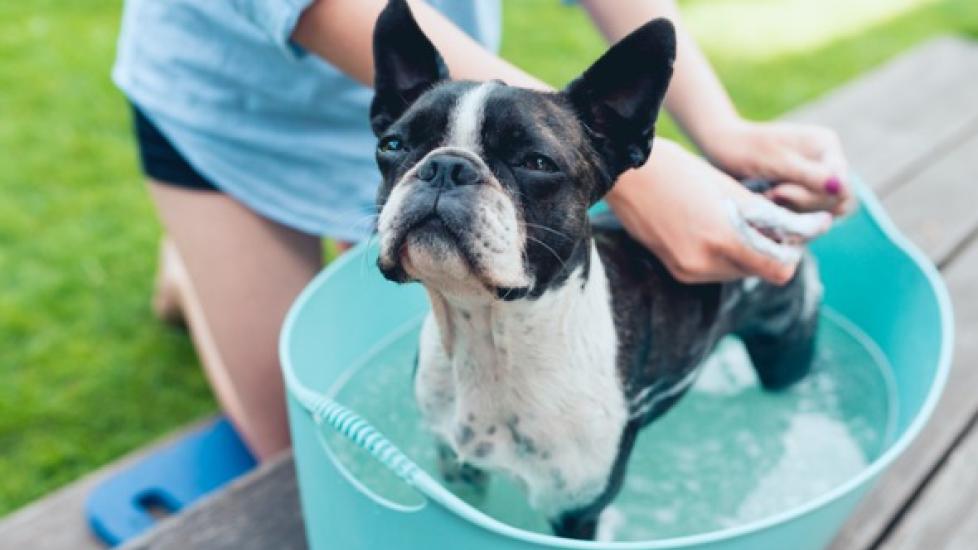How to Make an Oatmeal Bath for Dogs With Itchy Skin
Many dogs will experience dry skin, itchy skin, or some type of skin issue at one time or another, whether it’s due to a change in weather or allergies.
When your pup is feeling itchy or their skin is irritated, it’s natural to want to help them. One at-home remedy for itchy skin that can help your dog feel better is an oatmeal bath.
More consistent itching or hot spots will need a veterinarian’s expertise, but if your dog only has minor itching or you notice some flaking in his coat, an oatmeal bath is a convenient and inexpensive home remedy.
Here’s everything you need to know about oatmeal baths for dogs.
Benefits of Oatmeal Baths for Dogs
What’s so magical about an oatmeal bath? Oatmeal is a skin protectant with anti-inflammatory properties that can help soothe itchy and irritated skin.
Oatmeal baths can help relieve a number of bothersome skin conditions, such as canine atopic dermatitis.
Oatmeal baths also help the skin form a protective barrier that keeps moisture in and slows the loss of hydrating ingredients from your dog’s skin.
Dog Oatmeal Bath Ingredients
This at-home remedy is so simple that you may have all the ingredients in your kitchen pantry already.
-
Blender, coffee grinder, or food processor
-
Plain, unflavored oatmeal (instant oatmeal, quick oats, or slow-cooking oats all work equally well)
-
½-1 cup of oatmeal for medium to large breeds
-
1/3 cup for smaller dogs
-
-
Warm water—but not hot, as hot water can dry out the skin and can worsen inflammation
-
A bathtub
You can add either of these options to increase the moisturizing properties of your homemade oatmeal bath:
- 1 cup of high-fat milk for an extra-creamy mixture
OR
- 2 tablespoons of avocado oil or olive oil
Dog Oatmeal Bath Recipe:
Now that you have your ingredients, here’s the recipe for the perfect oatmeal bath “shampoo.”
-
Blend or process the oats on the highest setting in your food processor, blender, or coffee grinder until you have a very fine, consistent powder.
-
Test 1 tablespoon of the powder to see if the oats are ground fine enough to absorb water. Stir the tablespoon of the ground oats into a glass of warm water.
-
If the oats easily absorb the water and the liquid becomes milky-looking with a smooth feel, you've blended long enough.
-
If the liquid doesn't turn milky, process the oats to grind them even finer. Test again. Repeat until you get a milky solution with a fine, silky feel.
How to Give a Dog an Oatmeal Bath
Once your oat powder is prepared, you are ready to give your dog a bath.
While bathing your dog, try to keep your pup from drinking the bathwater, although a lap or two of the solution will not be harmful.
-
Pour the oat powder into a tub of running warm water and stir evenly.
-
Fill the tub as much as your pup will allow. Most dogs will tolerate the water level to at least the bottom of their stomach, if not higher.
-
Put your pup in the tub.
-
Using a cup, slowly pour the solution over their body. You can gently rub some of the oatmeal directly onto any particularly bad areas.
-
After you have massaged the oatmeal into your dog’s skin and fur and let him soak for 10 minutes, rinse the mixture off with warm water.
-
Use a towel to dry your dog off and brush out their fur. Never use a hot hair dryer on a dog. Your pup will be slippery due to the moisture of the bath.
Oatmeal Bath for Dogs: Spot Treatments
If your dog has a localized itch or minor skin rash, it isn’t necessary to do a full-body oatmeal bath and soak.
You can apply a thicker paste directly to the affected area and leave it on for 15 to 20 minutes.
Use the same blended oatmeal recipe, but only mix in enough water to form a thick paste.
While oatmeal baths are not a cure all for skin conditions and diseases that dogs can get, they can be a great addition to your dog’s grooming routine, especially during drier winter months.
If your dog is suffering from fleas, yeast or bacterial skin infections, or another problem such as an endocrine imbalance, they will need prompt treatment from your veterinarian.
By: Laci Schaible, DVM, CVJ
Featured Image: iStock.com/Wojciech Kozielczyk
Help us make PetMD better
Was this article helpful?
